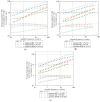Rheological Properties of Emulsions Stabilized by Cellulose Derivatives with the Addition of Ethyl Alcohol
- PMID: 39769690
- PMCID: PMC11677408
- DOI: 10.3390/ma17246090
Rheological Properties of Emulsions Stabilized by Cellulose Derivatives with the Addition of Ethyl Alcohol
Abstract
The paper presents the results of research on the rheological properties and stability of oil-in-water emulsions containing cellulose derivatives: methylcellulose, hydroxyethylcellulose, and hydroxypropylmethylcellulose. The continuous phase of the emulsion was a 70% ethanol (EtOH) solution by volume. The dispersed phase consisted of mineral, linseed, and canola oils (20% by volume). Rheological measurements were performed in both steady and oscillatory flow. Emulsion stability was assessed on visual observation and changes in droplet diameter over a period of 5 months after preparation. Relatively stable emulsions were obtained without the addition of low-molecular-weight surfactants, exhibiting viscoelastic properties. The presence of ethanol in the continuous phase significantly slowed down the processes of emulsion sedimentation or creaming, as well as droplet coalescence. The reasons for the slow phase separation were linked to changes in density and zero-shear viscosity of the continuous phase caused by the addition of EtOH. All emulsions were highly polydisperse, and the addition of methylcellulose and hydroxypropylmethylcellulose further led to the formation of strongly flocculated emulsions. Droplet flocculation resulted in highly viscoelastic fluids. In particular, for emulsions containing hydroxypropylmethylcellulose, the ratio of the storage modulus to the loss modulus approached a value close to 0.1, which is characteristic of gels.
Keywords: cellulose derivatives; emulsions; emulsions stability; viscoelsticity.
Conflict of interest statement
The authors declare no conflicts of interest.
Figures






Similar articles
-
Influence of Ethanol on Emulsions Stabilized by Low Molecular Weight Surfactants.J Food Sci. 2020 Jan;85(1):28-35. doi: 10.1111/1750-3841.14947. Epub 2019 Dec 16. J Food Sci. 2020. PMID: 31840826 Free PMC article.
-
Stabilization of ginger essential oil Pickering emulsions by pineapple cellulose nanocrystals.Curr Res Food Sci. 2023 Aug 25;7:100575. doi: 10.1016/j.crfs.2023.100575. eCollection 2023. Curr Res Food Sci. 2023. PMID: 37680695 Free PMC article.
-
Stability and rheology of emulsions containing sodium caseinate: combined effects of ionic calcium and alcohol.J Colloid Interface Sci. 2004 Jun 15;274(2):673-86. doi: 10.1016/j.jcis.2003.12.045. J Colloid Interface Sci. 2004. PMID: 15144844
-
Principles of emulsion stabilization with special reference to polymeric surfactants.J Cosmet Sci. 2006 Mar-Apr;57(2):153-69. J Cosmet Sci. 2006. PMID: 16688378 Review.
-
Viscoelastic properties of sterically stabilised emulsions and their stability.Adv Colloid Interface Sci. 2015 Aug;222:692-708. doi: 10.1016/j.cis.2015.03.001. Epub 2015 Mar 12. Adv Colloid Interface Sci. 2015. PMID: 25900262 Review.
Cited by
-
Effect of Addition of Spheroidal Cellulose Powders on Physicochemical and Functional Properties of Cosmetic Emulsions.Polymers (Basel). 2025 Jul 12;17(14):1926. doi: 10.3390/polym17141926. Polymers (Basel). 2025. PMID: 40732805 Free PMC article.
References
-
- Mohanty A.K., Misra M., Drzal L.T. Natural Fibers, Biopolimers and Biocomposites. Taylor & Francis Group; Bacon Raton, FL, USA: 2005.
-
- Abdulkhani A., Sousefi M.D., Ashori A., Ebrahimi G. Preparation and Characterization of Sodium Carboxymethyl Cellulose/Silk Fibroin/Graphene Oxide Nanocomposite Films. Polym. Test. 2016;52:218–224. doi: 10.1016/j.polymertesting.2016.03.020. - DOI
-
- Santa-Comba A., Pereira A., Lemos R., Santos D., Amarante J., Pinto M., Tavares P., Bahia F. Evaluation of Carboxymethylcellulose, Hydroxypropylmethylcellulose, and Aluminum Hydroxide as Potential Carriers for RhBMP-2. J. Biomed. Mater. Res. 2001;55:396–400. doi: 10.1002/1097-4636(20010605)55:3<396::AID-JBM1028>3.0.CO;2-Q. - DOI - PubMed
Grants and funding
LinkOut - more resources
Full Text Sources

